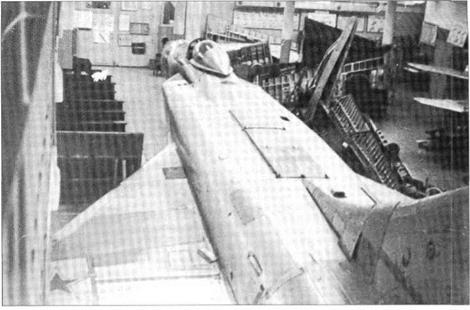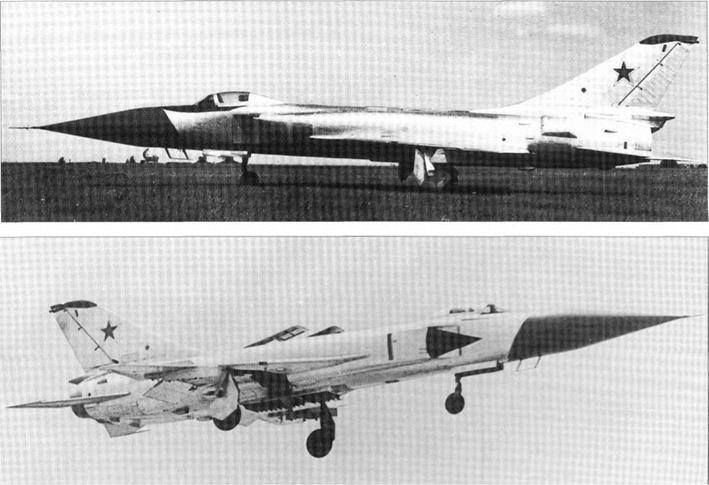Sukhoi T-58VD
Purpose: To provide full-scale STOL jet-lift data to support the T6-1.
Design Bureau: OKB-51 of P O Sukhoi, Moscow.
Early history of the T6-1 (see page 178) revolved around how best to create a formidable tactical aircraft with a short field length. One of the obvious known methods of making a STOL (short take-off and landing) aircraft was to fit it with additional jet engines arranged vertically to help lift the aircraft at low speeds. In January 1965 the T-58D-1, the first prototype ofwhat was to become the Su – 15 interceptor, was taken off its normal flight programme and returned to an OKB factory. Here it was modified as the T-58VD, the designation meaning Vertikalnyye Dvigateli, vertical engines. Managed by R Yarmarkov, who had been leading engineer throughout T-58D testing, ground running trials of the VD began in December 1966. This work required an enormous test installation built at the OKB-51 which used a 15,000hp NK-12 turboprop to blast air at various speeds past the T-58VD while it performed at up to full power on all five engines. It was mounted on a special
platform fitted with straingauges to measure the thrust, drag and apparent weight. When these tests were completed, the T-58VD was taken to the LII at Zhukovskii where it began its flight-test programme on 6th June 1966. Initial testing was handled by Yevgenii Solov’yov, who was later joined by the OKB’s Vladimir Ilyushin. On 9th June 1967 this aircraft was flown by Solov’yov at the Domodye – dovo airshow, where NATO called it ‘Flagon-B’. Its basic test programme finished two weeks later. It then briefly tested the ogival (convex curved) radome used on later Su – 15 aircraft and the UPAZ inflight-refuelling pod. It was then transferred to the Moscow Aviation Institute where it was used as an educational aid.
The original T-58D-1 was built as an outstanding interceptor for the IA-PVO air-defence force, with Mach 2.1 speed and armament of K-8M (R-98) missiles. Powered by two R-l 1F2S-300 turbojets (as fitted to the MiG-21 at that time), each with a maximum afterburning rating of 6,175kg (13,6131b), it had pointed delta wings with a leading-edge angle of 60°, fitted with blown flaps. The wings looked very small in comparison with
the fuselage, which had backswept rectangular variable-geometry engine inlets on each side. To convert it into the T-58VD a completely new centre fuselage was spliced in. This used portions of the original air ducts to the main engines but separated them by new centreline bays for three lift jets. The front bay housed a single RD-36-35 turbojet of P A Kolesov design with a thrust of 2,300kg (5,1801b). One of the wing main-spar bulkheads came next, behind which was a bay housing two more RD-36-35 engines in tandem. Each bay was fireproof and fitted with all the support systems shown to be needed in previous jet-lift aircraft. On top were large louvred inlet doors each hinged upward at the rear, while underneath were pilot-controlled cascade vanes for vectoring the lift-jet thrust fore and aft. Another important modification was to redesign the outer wing from just inboard of the fence, reducing the leading-edge sweep to 45° and extending the aileron to terminate just inboard of the new squared-off tip. Apart from the missile pylons
|
military equipment was removed, and a new telemetry system was fitted with a distinctive twin-blade antenna under the nose.
 The jet-lift conversion reduced take-off speed and ground run from 390km/h (242mph) and 1,170m (3,839ft) to a less frantic 290km/h (ISOmph) and only 500m (1,640ft). Landing speeds and distances were reduced from 315km/h (196mph) and
The jet-lift conversion reduced take-off speed and ground run from 390km/h (242mph) and 1,170m (3,839ft) to a less frantic 290km/h (ISOmph) and only 500m (1,640ft). Landing speeds and distances were reduced from 315km/h (196mph) and
1,000m (3,281ft) to 240km/h (149mph) and 600m (1,969ft). This was achieved at the expense of reduced internal fuel capacity and sharply increased fuel consumption at takeoff and landing. Moreover, it was discovered during initial flight testing that the longitudinal locations of the three lift engines had been miscalculated. Operation of the front RD-36- 35 caused a nose-up pitching moment which the pilot could not counteract at speeds below about 320km/h (199mph), so this lift engine could not be used on landings.
|












